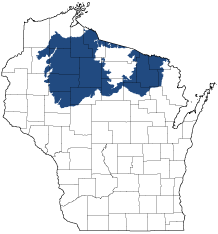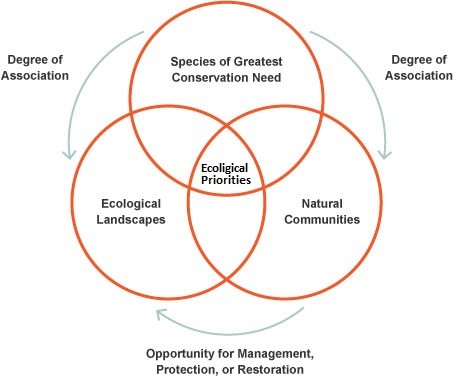North Central Forest
Ecological Landscape
Download the North Central Forest chapter [PDF] of the Ecological Landscapes of Wisconsin. This chapter provides a detailed assessment of the ecological and socioeconomic conditions for the North Central Forest.
It also identifies important planning and management considerations and suggests management opportunities that are compatible with the ecology of the landscape. The tabs below provide additional information.
- Physical and Biotic Environment
-
Physical and Biotic Environment
Size 9,543 square miles (6,107,516 acres), representing 17.1% of the total land area of the state. Climate Typical of northern Wisconsin, mean growing season in the North Central Forest is 115 days, the shortest growing season of all Ecological Landscapes in the state. The mean annual temperature is 40.3 deg. F. Summer temperatures can be cold or freezing at night in the low-lying areas, limiting the occurrence of some biota. The mean annual precipitation is 32.3 inches and the mean annual snowfall is 63 inches. However, heavier snowfall can occur closer to Lake Superior, especially in the northwestern part of the Ecological Landscape in the topographically higher Penokee-Gogebic Iron Range. The cool temperatures and short growing season are not conducive to supporting agricultural row crops such as corn in most parts of the Ecological Landscape. Only six percent of the North Central Forest is in agricultural use. The climate is especially favorable for the growth of forests, which cover roughly 75% of the Ecological Landscape. Bedrock Predominantly igneous and metamorphic rock, generally covered by 5 to 100 feet of glacial drift deposits. Geology & Landforms Landforms are characterized by end and ground moraines with some pitted outwash and bedrock-controlled areas. Kettle depressions and steep ridges are found in the northern portion of the North Central Forest. Two prominent areas here are the Penokee-Gogebic Iron Range in the north (which extends into Upper Michigan), and Timm's Hill, the highest point in Wisconsin (at 1,951 feet) in the south. Drumlins are important landforms in some parts of the North Central Forest. Soils Soils consist of sandy loams, sands, and silts. Organic soils, peats and mucks, are common in poorly drained lowlands. Hydrology Rivers, streams, and springs are common and found throughout this Ecological Landscape. Major rivers include the Wisconsin, Chippewa, Flambeau, Jump, Wolf, Pine, Popple, and Peshtigo. Large lakes include Namekagon, Courte Oreilles, Owen, Round, Butternut, North Twin, Metonga, Pelican, Pine, Kentuck, Pickerel, and Lucerne. Several large man-made flowages occur here such as the Chippewa, Turtle-Flambeau, Gile, Pine, and Mondeaux. There are several localized but significant concentrations of glacial kettle lakes associated with end and recessional moraines (e.g., the Perkinstown, Bloomer, Winegar, Birchwood Lakes, and Valhalla/Marenisco Moraines.) In southern Ashland and Bayfield counties, the concentrations of lakes are associated with till plains or outwash over till. Lakes here are due to dense till holding up the water table. Rare lake types in the North Central Forest include marl and meromictic lakes. Current Landcover Forests cover approximately 75% of this Ecological Landscape. The mesic northern hardwood forest is dominant, made up of sugar maple, basswood, and red maple, with some stands containing scattered hemlock, yellow birch, and/or white pine pockets. The aspen-birch forest type group is also abundant, followed by spruce-fir (most of the spruce-fir is lowland conifers on acid peat, not upland "boreal" forest). Forested and non-forested wetland communities are common and widespread. These include Northern Wet-mesic Forest (dominated by either northern white cedar or black ash), Northern Wet Forest (acid conifer swamps dominated by black spruce and/or tamarack), non-forested acid peatlands (bogs, fens, and muskegs), alder thicket, sedge meadow, and marsh (including wild rice marshes) are widespread in the North Central Forest. - Associated Rare Species and Natural Communities
-
Associated Rare Species and Natural Communities
Species of Greatest Conservation Need (SGCN) are associated with habitats (or natural communities) and places on the landscape. Understanding relationships among SGCN, natural communities and ecological landscapes help us make decisions about issues affecting SGCN and their habitat and how to respond. Download the Wildlife Action Plan association score spreadsheet to explore rare species and natural communities associated with this ecological landscape.
- General Management Opportunities
-
General Management Opportunities
The North Central Forest contains the best large-scale interior forest management opportunities in the state. There are opportunities to create or maintain large habitat patches, develop or re-establish greater connectivity between forest habitat patches and restore missing and diminished cover types. Restoring conifers to many hardwood forests is a major opportunity. Hemlock and yellow birch, once the dominant species in this landscape, are greatly reduced and declining. Both species are difficult to regenerate, so developing effective regeneration methods given deer herbivory challenges is a management opportunity.
Old forests are a rare and declining resource in Wisconsin. The North Central Forest offers excellent opportunities to manage areas for older forest within a context of outstanding aquatic features, intact and relatively undisturbed wetlands and vast public landholdings. Working forests could include areas with extended rotations, the development of old-growth forest characteristics and/or stands of "managed old-growth.".
Wetlands are abundant here and include forested, shrub and herbaceous types. Collectively, wet-mesic forests, including Northern Wet-mesic Forest and Hardwood Swamp, are more common here than anywhere else in the state. Acid peatlands are common and widespread. Ephemeral Ponds are abundant and provide important habitat for numerous animals. Protecting the hydrology and integrity of the landscape's wetlands is a major opportunity.
Aquatic resources are in good condition compared to many areas elsewhere in the state. Water quality is high, sediment and pollutant loads are low, flow levels tend to follow normal patterns on many streams and the diversity of aquatic organisms is significant. Maintaining the existing high percentage of forest cover within watersheds is, arguably, the most critical factor in maintaining high water quality and supporting all of the aquatic species native to northern Wisconsin's lakes and streams.
Invasive species are, generally, less abundant here than in many other ecological landscapes, especially those in the southern half of the state. However, invasive species detections are increasing in this landscape. Controlling these species before they become abundant, as they have in many other parts of the state, is an important opportunity as both control efforts and costs are more manageable when problems are still localized.
There are good opportunities to maintain communities and habitats that are either especially well-represented here or rare elsewhere in the state. These include lowland forests dominated either by white cedar or black ash, acid peatlands, bedrock glades and moist cliffs. It should be possible to provide for the needs of the vast majority of plants and animals native to the North Central Forest, including the many rare species that have been documented.
- Considerations for Property Planning
-
Considerations for Property Planning
One of the major considerations in the North Central Forest is clarification of the roles played by and ecological relationships among public, private, industrial, and tribal lands from a conservation, socioeconomic, and recreational perspectives. In recent years there has been documentation of widespread negative impacts to forests from: excessive deer browse; invasive earthworms, insects, plants and pathogens; divestitures of large private holdings (especially estates and industrial forests); increased parcelization; and the development of shoreline habitats. Other important factors to consider include: the potential implications of climate change; ecological impacts of increased biomass harvest; forest type conversions; forest simplification and homogenization; and the need to develop ecologically appropriate and economically viable restoration methods for mesic forests.
- Maps
-
Maps
Printable maps of ecological landscapes are available in the Ecological Landscapes of Wisconsin document and map library.
Many of the map layers, such as Land Type Associations, Conservation Opportunity Areas and Finley’s 1800s vegetation polygons are available to download from the WI DNR GIS Open Data portal.


